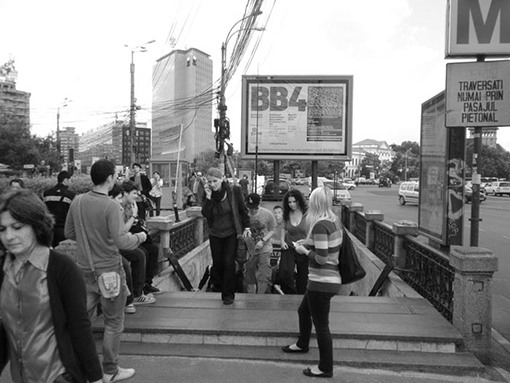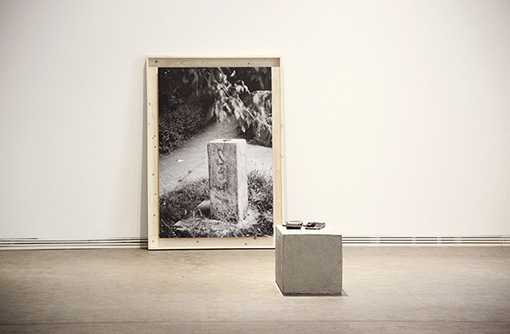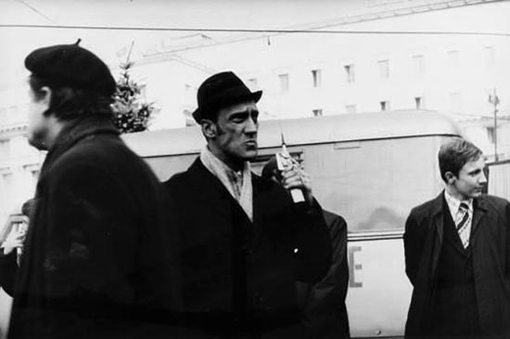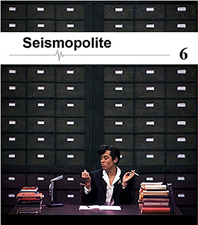December 28, 2013
Learning from Bucharest.
Rethinking ‘white spots’ of art production in Central and Southeastern Europe
Written by Belinda Grace Gardner
Oscillating between post-communist repercussions and the problematic dynamics of turbo-capitalism, Bucharest has been hosting an international Biennale for contemporary art since 2005. The Biennale epitomizes the intricate dynamics of art practice and art reception characteristic of the complex cultural texture of Central and Southeastern European as a whole, raising the question whether it might be time to venture beyond the traditional “road maps” delineated by national boundaries and outdated modes of perception.
Already at first sight, Romania’s vibrant, yet also consistently deteriorating capital reveals its complexity as a threshold arena resonant with intense contrasts swaying between East and West, post-Communist repercussions, and the problematic dynamics of turbo-capitalism that have seized Eastern and Central European societies in the wake of the collapse of Socialism. Before this backdrop, the Bucharest Biennale was initiated in 2005 by two local art theorists and curators, Razvan Ion, born in 1970, and Eugen Radescu, born in 1978: to date, it is one of very few significant Biennale projects dedicated to the presentation of contemporary art in the region.
With the Bucharest Biennale, Ion and Radescu sought to promote an “awareness and dissemination of the culture, particularly in the fields of the arts, by means of exchanges and cultural cooperation within Europe and beyond.”[1] They started out with an Internet platform for photography before establishing the Pavilion journal for politics and culture in 2001, from which the Biennale emerged as a forum for the presentation of current art and the discussion of aesthetic, political, and social issues in the face of the shifts and upheavals impacting Central Europe as such and Bucharest in particular today.
For the 4th edition of the Bucharest Biennale, which opened in May 2010, Ion and Radescu had invited Felix Vogel, a young German art and media theorist, to conceive the program and choose the participating artists, seeking to spark the interest of Western media. Vogel, who had first become acquainted with the art scene in Bucharest when visiting the Biennale there in 2006, had invited prolific protagonists of contemporary art along with young, emerging and lesser-known art producers. Born in 1987 and meanwhile holding a position at the University of Zurich, he was championed as the “youngest curator of a Biennale ever,”[2] following in the footsteps of Eugen Radescu, who was in charge of the first edition of the Bucharest Biennale, the Hungarian critic and curator Zsolt Petranyi, who conceived the BB2 in 2006, and the Swedish curators Jan-Erik Lundström and Johan Sjöström, responsible for the BB3 in 2008, neither of which, however, had hitherto been able to draw much outside attention to the event.

Although Vogel, who was virtually unknown as a curator at the time, piqued curiosity, if only for the reason that because of his young age he promised to introduce a cutting edge awareness to the Biennale, the press conference of the BB4 held at the high-rise InterContinental Hotel on busy Nicolae Balcescu Boulevard was more or less devoid of the usual suspects who can otherwise be observed flocking to each and every Biennale event. Though well attended, most critics present were from the larger region of Romania and adjoining countries, extending towards the West to Austria. Thus, together with some other journals of art, architecture, and philosophy such as the London magazine Afterall, Vienna-based Springerin was among the small number of Western publications supporting the Biennale as a media partner.
Surprisingly, although the curator himself was from Germany, Hamburg-based art magazine was one of the few prominent art media in Germany to carry a larger piece on the exhibition with a special focus on the cultural situation of Bucharest as a whole. Taking 1989 as “the starting point of a new era,”art author Alain Bieber came to the jubilant conclusion in June 2010 that “contemporary Romanian art has not yet come of age. It is still in its puberty, is defiant and wild, untamed, and keen on experimenting. […] A whiff of revolution is in the air.”[3] In a way, despite its unquestionable earnestness, his celebration of an “untamed” local art practice followed the logic of the Western art market gaze, which is always keenly on the lookout for the “new” in terms of the “defiant and wild” that might serve to reignite its own diminishing spark.
In fact, all in all the BB4 was a rather subtle and compact affair. Right around the corner of the InterContinental Hotel in the city center, one of the five venues of the Biennale was tucked away in a quiet side street. The Paradis Garaj, at the time one of the few artist-run spaces in Bucharest situated in a former garage covered with ivy, featured the three-part film Otolith produced by the meanwhile very successful London-based Otolith Group comprised of Anjalika Sagar and Kodwo Eshun. Leaping between various realities, times, and places, the film travels from a distant future into the recent past, conjoining and subverting utopias of yesterday and political visions of tomorrow. The film might even be seen as programmatic for the historically charged thematic underpinning developed by Vogel for the BB4. Entitled Handlung. On Producing Possibilities, the BB4 was based upon the notion of the “vita activa” derived from Hannah Arendt’s treatise The Human Condition of 1958. Revolving around the conflation of action and narrative resonant in the German term “Handlung,”[4] it was linked to forms of art practice that question, disrupt, and intervene in social reality, while implicitly relating to the collapse of European culture during the reign of Fascism and its reinvention in the post-World War II era. Vogel also drew upon the writings of the London-based political theorist Chantal Mouffe—in particular, upon her thesis of “agonistic pluralism,”[5] where conflict becomes a source of creative energy and change within a democratic social system.

While a number of artistic interventions planned for the event could not be realized due to a lack of funding, the BB4 was certainly not short of conflicts. Thus, for instance, the photomontage series Tit for Twat created by Los Angeles-based artist Kaucyila Brooke, who transposed the biblical story of Adam and Eve into an interracial lesbian narrative, was censured by the management of the National Geology Museum because of its supposedly pornographic subject matter and consequently not shown at this site. In a leaflet added to the exhibition catalogue, the organizers of the Biennale expressed their “regret that in a democratic country, member of the European Union, such Stalinist acts can still occur.”[6] The fact that they did not supply another venue for Brooke’s work was in turn heavily criticized by a group of local and international artists in the blog ArtLeaks in July 2011[7]: a critique revealing the conflicting interests even among those already engaged in the arts, making joint action on a larger scale difficult to implement.
Apart from the National Geology Museum, the Paradis Garaj, and the independent artist-run Center for Visual Introspection, conceived to counter “the restrictive institutional frameworks present within the Romanian cultural sphere,”[8] the BB4 venues included the Institute of Political Research, and the Pavilion UniCredit center for contemporary art and culture. Ion and Radescu established the Pavilion center, which has become the conceptual hub of the Biennale and recently moved location to downtown Bucharest, in 2009 in former office spaces of the UniCredit Tiriac Bank. Together with Pilsner Urquell, UniCredit was originally one of the main sponsors of the Bucharest Biennale—a commercial tie that was also sharply rejected by the artists in the blog mentioned, who renamed the center “Pavilion Discredit,”[9] asserting the claim to economically autonomous forms of art practice and presentation, which in real life, regardless of the national context, are difficult, if not impossible to uphold.
Vogel had assembled about 40 predominantly European artists in the at times slightly brittle framework of the BB4, ranging from the prolific experimental German filmmaker Alexander Kluge to New York-based German Documenta 12 participant Andrea Geyer who restaged the Eichmann trial in her disturbing multi-channel video installation Criminal Case 40/61: Reverb of 2009, relating to Hannah Arendt’s Report on the Banality of Evil. Most participants of the BB4, such as the Basque artist Asier Mendizabal, who investigates the meaning of socio-political signs, constructions, and monuments in his work, or the Dutch artist Nicoline van Harskamp, who analyzes the role of spoken words as instruments of power, are acutely engaged in exploring political issues. Strikingly few artists from Romania were present in this Biennale edition, one of these being the major conceptual artist Ion Grigorescu, whose secretly produced photo documentation Electoral meeting from 1975 reveals the oppressiveness of the former Ceausescu regime.

But then, Vogel didn’t have the intention to put together an exhibition that showcased a specific national adherence or context. His objective was rather to expand the boundaries of perception towards a more free-floating art practice carried out by protagonists who do not necessarily define themselves in terms of their particular nationalities, but instead through a shared interest in broader themes that are impacting contemporary societies in today’s globalized times per se. In an interview with Markus Miessen from 2008 republished in excerpts on the webpage of the BB4, Vogel aptly elucidated why he does not believe in reading Europe in terms of a “traditional road map” or even a spatial definition of “territorial construction,” stating, “If you have just this ‘road map atlas’ perception and you are only changing it according to changes on this particular map you are just reproducing today’s political discourses. I would rather continue to differ from this and produce personal as opposed to spatial and political border-related maps, which could have the possibility to overcome these strict and more or less random ‘atlases’.”[10] In this respect, Vogel is entirely in keeping with his generation’s practice of freely moving around in an unlimited common space of communication unfolding in today’s social media on the Internet, where changeable immaterial territories are fleetingly occupied on the mutual basis of likes or dislikes.
From the very beginning, the initiators of the Bucharest Biennale hoped to trigger a dialogue between periphery and center, East and West, non-established and established art production, and thus expressly invited international curators from outside of Romania as curators to lend the Biennale international scope and visibility. Yet even after five increasingly ambitious Biennale editions, the most recent BB5 in 2012 having been conceived by the New York-based Scottish curator Anne Barlow, , Bucharest and Romania as such are still largely perceived as “white spots” on the map of the so-called art world—with the exception of a few global players such as Dan Perjovschi who have made it onto the master plan of the Western art market, or giants of art history such as Constantin Brancusi.
The appointment of the renowned curator and director of the Kunsthalle Wien Nicolaus Schafhausen by the Biennale organizers to be in charge of this year’s BB6 (duration: May 23—July 24, 2014) was yet another step aimed at bringing Bucharest into the focus of the international eye. With his BB6 project, Schafhausen, born in 1965 in Düsseldorf, was planning to create new lines of understanding by spanning a bridge between the Bucharest Biennale and the Kunsthalle Wien . His Biennale concept, entitled Belonging & Longing, revolved around questions of identity and desire in a time in which former notions of the nation-state have dissolved, and the growing “dichotomy between the Other and the Self” has become a trigger for seeking a place of identity in the “Elsewhere.”[11] In contrast to previous Bucharest Biennale editions, however, Schafhausen was not intending to place a focus upon international art. Instead, he was going to exclusively present artists from Romania working either in their home environment or abroad, highlighting those who have disappeared into the “black holes” of art perception, both in the contexts of the Western art market and those of their native country. A special emphasis was to be placed on investigating the “continued migration of young artists”[12] who are leaving their countries due to a lack of infrastructure and financial means.
Dan Perjovschi with his socio-political cartoon-like drawings and Lia Perjovschi, who founded the Contemporary Art Archive in Bucharest together with her husband and continues to work with a wide range of methods and media of processing knowledge, are among the small circle of Romanian artists today who have maintained their position as critical agents in the local context of Bucharest while being perceived far beyond the limits of their native environment.
The Western public’s general lack of knowledge about the local art production is precisely why, in contrast to the BB organizers who for years have been seeking to create an event with international flair and impact, it made no sense to Schafhausen to restage a biennale format that already exists in variations all over the world, showcasing artists who are already omnipresent in the globe-spanning exhibition circuit. In his view, it seemed much more vital to throw a light onto the specific art scenes of Bucharest and the surrounding regions, which as yet have remained largely unrecognized, posing the question from a Western vantage point as to “who actually knows about these scenes and what is going on in these areas?”
In collaboration with the renowned Austrian media philosopher Peter Weibel, Director of the ZKM in Karlsruhe, Germany, and the Museum of Applied Arts (MAK) in Vienna, a conference was planned to take place on the opening weekend of the BB6 dedicated to issues of ‘Longing and Belonging’ in today’s shifting societies: among these the repercussions of the financial crisis on the cultural life of the region, for instance, today’s status of artists as contemporary “migrant workers,” the dichotomy of national identity versus the global art market, and the question of whether a localized concept of “home” is a vital prerequisite for artistic work to be able to evolve in the first place. Schafhausen’s team and collaborators worked on the BB6 concept for one and a half years. Against many obstacles, they were finally able to secure funding for both the exhibition and the conference. With Romania being one the poorest countries in the European Union, the Bucharest Biennale is massively underfinanced. In addition, there is no governmental support whatsoever, making the Biennale extremely difficult to maintain as a trans-national forum of aesthetic practice and discussion.
Then, at the end of January, shortly before the Kunsthalle Wien was going to release both the names of the participating artists and the venues of the BB6, the organizers of the Bucharest Biennale issued a press statement proudly announcing the upcoming exhibition, including only the information that it would take place under the auspices of Nicolaus Schafhausen, followed by a long list of institutions and sponsors supporting the event. Nicolaus Schafhausen had not been informed of this beforehand. He immediately canceled his curatorship of the BB6, stating that the release contained false information on various levels. As it turned out, before the backdrop of long-standing conflicts with the local art scene, the organizers of the Bucharest Biennale had tried to torpedo Schafhausen’s curatorial decisions a number of times in the planning stage, repeatedly blacklisting artists who had been invited to participate in the BB6. While Schafhausen did not comply with these interferences in his concept, this remained a source of discord.
Opposing attitudes to curatorial freedom are certainly one vital issue, yet the underlying problem seems to be more about the conflicting notions of what might serve to surmount the barriers between periphery and center, awareness and disregard of art production in Bucharest and other parts of Central and Eastern Europe. Schafhausen was going to present the contributions by Romanian artists (most works commissioned were going to be shown as sketches or models, due to the high expense of transport and insurance) as a kind of preliminary, open-ended survey involving propositions rather than full-fledged works, concepts rather than coherent, finalized results. The Bucharest-based organizers, in turn, appear not to entirely trust in their local resources, if this metaphor may be used, as being capable of drawing and retaining the attention of the jaded Western gaze. The unfinished does not appeal so strongly perhaps to those who have been living in an environment that itself is in a constant state of rebuilding and reinventing itself.
Meanwhile, not even a week after Schafhausen resigned as curator of the BB6, the Biennale organizers pulled a new curatorial team out of their hat to head the event. This team was presented at a press conference held on February 5 in Bucharest. The fact that this happened with such amazing speed is slightly astonishing. Still, both curators are already affiliated to the Bucharest Biennale through collaborations with Pavilion, the theoretical basis and art platform run by the BB initiators and organizers Razvan Ion and Eugen Radescu. The BB6 duo consists of the Hungarian artist and curator Gergö Horváth (b. 1993), who is interested in “makeshift politics and DIY social structures,” and the independent theorist and social anthropologist Stefan Voicu (b. 1988). The latter studied at the University of Bucharest and is currently conducting research in “the articulation of experimental ethnographies of art, labor and critique assemblages.” Voicu lives and works in Italy. On the day of their presentation to the public, a list of participants had not yet been revealed. The title of their concept, Apprehension. Understanding through Fear of Understanding, is somewhat vague, if not without intriguing possibilities and intricacies. In any case, the BB6 will take place, even without Nicolaus Schafhausen who would have guaranteed publicity already due to his high profile and international standing as a curator.
.
Eastern and Central Europe are in the midst of highly charged creative processes and strong shifts. Slowly, the boundaries of art reception that are still to a certain degree delineated by the historical Iron Curtain paradigms of East and West are shifting as well. These processes not only impact the art production but also the theoretical debates alive in the region, which have an acuity that is missing in the still—despite the financial crises beginning to strike these as well—relatively saturated societies of the West. The challenge will be to put the “white spots” of art production (back) onto the map of art perception without allowing these to be usurped by the global art market. And, on the other hand, without letting internal conflicts between artists and curators, theorists and other protagonists of the still emerging art scenes in these areas prevent the slow but steady progress in pulling down the very barriers that still define the Western perspective on current art. These initiatives, and notably among them the Bucharest Biennale, are all the more striking for their perseverance in view of the severe financial and other difficulties that continue to encumber them. Yet, there is still much work to be done, particularly with respect to how the so-called peripheries view the so-called centers and vice versa, including the contrasting expectations determining the different points of departure on both sides. One might hope that ultimately the self-rejuvenating energy that the initiatives in the peripheries of the Western art centers generate will be a potent force for extending the networks of understanding and for bringing forth new, wide-open mental landscapes, which, together with the boundless virtual communities springing up around the world, will serve to transcend the old demarcations of awareness. In this sense, but also in relation to the conflicts that have disrupted the latest edition of the Biennale, there is much to learn from Bucharest, both in terms of rethinking the increasingly obsolete distinctions between center and periphery and in relation to venturing beyond the well-beaten paths of Western art perception.
[This text is a revised version of a lecture held by the author in Kosice on September 25, 2013, in the context of the 46th International Conference of AICA (September 24 – 27, 2013, Kosice & Bratislava, Slovakia: White Places – Black Holes). Multiple revisions were necessary due to the shifts and disruptions that kept the BB6 in a state of constant flux.]
Belinda Grace Gardner is an independent curator and lecturer of art theory, currently teaching at the University of Fine Arts, Hamburg, and the Leuphana University Lüneburg. She has worked as an arts editor, freelance art critic, and author for various newspapers, magazines, and radio stations.
[1] Quoted from a statement published on the website of the Bucharest Biennale: http://bucharestbiennale.org/history.html (accessed on July 16, 2013).
[2] Quoted from the press release of the 4th Bucharest Biennale, July 2008: http://bucharestbiennale.org/old_site/old_ed/2010/pressrelease_03072008.pdf (accessed on July 20, 2013).
[3] Cf. Alain Bieber: „Kunstszene Bukarest, Rumänien. Palastrevolution,“ in: art magazine, June 18, 2010: http://www.art-magazin.de/szene/30729/kunstszene_bukarest_rumaenien (accessed on July 26, 2013).
[4] Cf. Felix Vogel on his concept, published on the website of the 4th Bucharest Biennale: http://bucharestbiennale.org/old_site/old_ed/2010/concept.html (accessed on July 21, 2013), and in his preface: „Handlung. On Producing Possibilities,“ in: Pavilion, journal for politics and culture, Vol. 15, Handlung. On Producing Possibilities (reader of the Bucharest Biennale 4, May 21–July 25 2010), Razvan Ion and Eugen Radescu (eds.), Bucharest 2010, pp. 7–13.
[5] Cf. Chantal Mouffe: „Agonistic Democracy and Radical Politics,“ in: Razvan Ion and Eugen Radescu, Bucharest 2010 (see note 4), pp. 248-253.
[6] Cf. leaflet attached to the catalogue of the 4th Bucharest Biennale, Bucharest 2010 (see note 4).
[7] Cf. „Pavilion UniCredit 2010/2011 – a collective protest letter“ on the blog Artleaks: http://art-leaks.org/2011/07/10/a-protest-letter-against-pavilion-unicredits-practices/ (accessed on July 24, 2013).
[8] Statement in the BB4 reader, Razvan Ion and Eugen Radescu, Bucharest 2010 (see note 4), p. 433.
[9] Cf. ibid.
[10] From a conversation between Felix Vogel and Markus Miessen on the occasion of the appointment of Felix Vogel as curator of the 4th Bucharest Biennale, quoted from the website of the 4th Bucharest Biennale, reprint of a shortened excerpt from: East Coast Europe, Markus Miessen (ed.), Sternberg Press 2008: (accessed on July 26, 2013).
[11] Quoted from concept papers that Nicolaus Schafhausen emailed to the author on July 5, 2013..
[12] Ibid.









